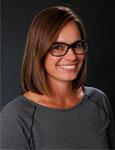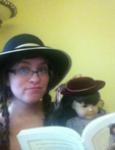Allison Welch's show Meet Allison: an American Girl was in the James Watrous Gallery earlier this year, attracting art and doll fans alike. Exhibitions Coordinator Rachel Bruya took the time to ask Welch a few questions about the exhibition and her artistic process.

Rachel Bruya (RB): For those readers who didn’t see your show, Meet Allison: an American Girl, can you describe the project?
Allison Welch (AW): My project is a photographic illustration of the American Girl dolls, books, and culture. I am drawn to the American Girl doll collection for its ability to consolidate major turning points in American history into accessible products for children. Established in 1986, the toy line represents girls of various ethnicities and historic American eras through clothing, accessories, and novellas. My focus is on the historic characters who were introduced between the mid-1980’s to 2000’s, before the BeForever line was launched in 2001. These were the stories I grew up reading, and the dolls I played with, so it was a natural decision to center my work from this perspective.
For my photographs, I hand craft costumes to perfectly match those worn by the dolls, and collaborate with historic museums around the country to make the final images. It can take up to 6 months of correspondence with a location to gain necessary access to the facilities. Often I am the first fine art photographer to write such a proposal, and must work closely with facility directors before I can arrive on set. After spending endless hours creating my garments, gathering accessories, and working with museums, I travel to a different state with a pack of film, a tripod, and a medium-format camera. The result of my effort is a series of self-portraits of myself as the American Girl doll characters.
I am pleased to show at the James Watrous Gallery, because it the first time that I have not only presented my photographs, but also the clothing, dolls, and accessories that went in to the work. My project is quite dependent on process, and so I feel that it is important and interesting to display material from behind the scenes.

RB: Can you talk about your background and how it influences your artwork. What do you feel are the three most important things from your childhood that influence what you do now?
AW: When I was a kid, I had an unquenchable interest in handcrafts. Every week at the library, I would check out books on cross-stitching, knitting, sewing, paper-mâché, doll house construction—really anything that involved making. I was primarily self-taught, because neither my grandmother nor my mother had skills beyond basic mending. One summer, I remember trying to decide between learning how to tat (lace making!) and beading. I was 10.
So much of my interest in handcrafts came from the novels I read. My favorite subject was about girls my age living in different eras, so naturally the American Girl books were at the top of my list. Another series that I pored over was Dear America (about 36 books in all). With the subject still centered on girls from different eras, these were more advanced books written in the form of diary entries.
The third great influence from my childhood was the fact that I was awful at playing sports. I was terrible! I was much more concerned about building a narrative around what was happening than scoring goals. I lived out great fantasies that the playing fields were definitely NOT in Illinois, but rather on royal land that looked remotely similar to England (a place I had only read about). Having no skill in sports positively fed my identity as an artist. With the support from my parents and teachers, I shifted towards activities that challenged me in the best ways possible.

RB: For this show, you have included a tableau of an American Girl doll that looks like you and she is making a dress for herself, and her “doll” is sitting on the chair nearby. This seems to be charting new territory for you. How did you come up with the idea?
AW: Making myself as American Girl doll, mimicking how I carry out my own research, came from a need for comic relief. I had just finished attending Review Santa Fe in late June, 2014. This is an intense, invite-only, three day portfolio review, which I like to explain as try-outs for galleries, museums, magazines, etc. I decided that while my work was often perceived as serious portraits, I could also present some aspects of it in a playful way. The ability to make a look-alike American Girl doll was not new to me, though. Around 2000, the company started marketing modern dolls who not only looked like their girls, but shared the same hobbies in miniature form. Your doll could ski like you, play the cello, ride horses, camp, go to school. So, it was an easy step to start a collection of my own, using myself as the doll. I think, eventually, it would be exciting to tell the story of my research through the original American Girl template—Meet Allison; Allison Learns a Lesson; Allison’s Surprise, Happy Birthday, Allison!; Allison Saves the Day; Changes for Allison. Until then, I will continue to build a little tableau of myself for shows, and of course, for my own amusement.

RB: I can see how you painstakingly recreate the covers of the American Girl books. Many of our visitors asked a lot of questions about how you put the images together—you’ve already answered that you shoot the images on location at historical sites and you make the clothing and blankets or wraps. Where do you get the furniture, objects and the accessories that you wear? How do you decide if you will wear glasses and choose your facial expression?
AW: Pairing with museums allows me to have access to the furniture on site, so I really only have to find small accessories for each photograph. I usually go to a museum with the assumption that I cannot touch or move anything, though, which is often the case. If I can rearrange furniture, or sit, I am elated! For the accessories that I do supply, I purchase items online at local antique shops, and even in the town that I’m visiting. The ceramic vase in Happy Birthday, Josefina! was found at an awesome home goods store called Jackalope in Santa Fe. It was the day before my photo shoot at Las Golondrinas, so of course I was on a wild goose chase to find all of the birthday accessories.
My facial expressions are influenced by contemporary portraiture, which has steered away from the smiling, “say cheese!” look found in snapshots. I am also moved by early photography, when exposure times were excruciatingly long. To hold a smile for a few minutes would have been difficult, so a resting, neutral expression was commonplace. I decided early on to wear my glasses in the photographs to maintain a sense of personal identity. I want to reaffirm in each image that this person is Allison, and not quite Kirsten, or Josefina, or Samantha. It is important for me to make this distinction, along with other decisions. These image function as self-portraits, and so I cannot portray myself as anyone except myself.
RB: What’s next for you?
AW: I started working on this project as a graduate student at the University of Iowa in 2011. My first character was Kirsten. I was drawn to her in part because of my location (I was immersed in a cultural interest in the Midwest, prairies, and pioneering) and also from my childhood memories of her stories. At the time, I felt that I would make a few images about the doll and then move on to another idea. But with the end of graduate school, I started thinking about how I could depict more characters from the series. Soon, I was making dresses for Samantha, Josefina, and Cécile and Marie-Grace. Eventually, I will retell the stories of all the American Girls. This project will take years to accomplish, with a great amount of collaboration, storytelling, and learning. I am honored and excited to be the American Girl.




